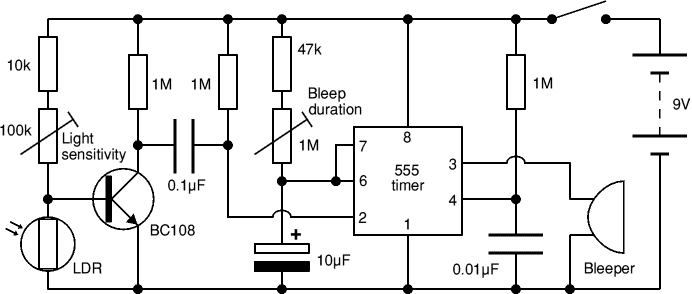
Simple 6-Input Alarm

This simple alarm circuit was designed for use in a combined garage and rumpus room. It can be assembled on Veroboard and uses just one IC plus a handful of additional components.
The alarm circuit is based on a single integrated circuit (IC), which serves as the core of the system, providing the necessary functionality for detection and alerting. The design is optimized for simplicity and ease of assembly, making it suitable for hobbyists and those with basic electronics skills.
The circuit typically includes a few essential components alongside the IC, such as resistors, capacitors, and a piezo buzzer for sound output. The resistors are used to set the sensitivity of the alarm and to limit current where necessary. Capacitors may be employed for noise filtering and stabilization of the power supply to the IC.
A motion sensor, such as a passive infrared (PIR) sensor, can be integrated into the circuit to detect movement within the garage or rumpus room. When motion is detected, the sensor sends a signal to the IC, triggering the alarm. The output from the IC can drive the piezo buzzer, producing a loud sound to alert occupants of any unauthorized entry.
The circuit can be powered by a standard DC power supply, making it easy to integrate into existing electrical systems. Additionally, the use of Veroboard allows for a compact and organized layout, facilitating troubleshooting and modifications if needed.
Overall, this alarm circuit is an effective solution for enhancing security in a multi-use space, providing a reliable alerting mechanism with minimal complexity in design and assembly.This simple alarm circuit was designed for use in a combined garage and rumpus room. It can be assembled on Veroboard and uses just one IC plus a handful.. 🔗 External reference
The alarm circuit is based on a single integrated circuit (IC), which serves as the core of the system, providing the necessary functionality for detection and alerting. The design is optimized for simplicity and ease of assembly, making it suitable for hobbyists and those with basic electronics skills.
The circuit typically includes a few essential components alongside the IC, such as resistors, capacitors, and a piezo buzzer for sound output. The resistors are used to set the sensitivity of the alarm and to limit current where necessary. Capacitors may be employed for noise filtering and stabilization of the power supply to the IC.
A motion sensor, such as a passive infrared (PIR) sensor, can be integrated into the circuit to detect movement within the garage or rumpus room. When motion is detected, the sensor sends a signal to the IC, triggering the alarm. The output from the IC can drive the piezo buzzer, producing a loud sound to alert occupants of any unauthorized entry.
The circuit can be powered by a standard DC power supply, making it easy to integrate into existing electrical systems. Additionally, the use of Veroboard allows for a compact and organized layout, facilitating troubleshooting and modifications if needed.
Overall, this alarm circuit is an effective solution for enhancing security in a multi-use space, providing a reliable alerting mechanism with minimal complexity in design and assembly.This simple alarm circuit was designed for use in a combined garage and rumpus room. It can be assembled on Veroboard and uses just one IC plus a handful.. 🔗 External reference





